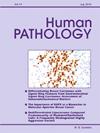连接滤泡性淋巴瘤的临床病理特征与遗传学:提高诊断准确性和亚型区分。
IF 2.7
2区 医学
Q2 PATHOLOGY
引用次数: 0
摘要
滤泡淋巴瘤(FL)是一种起源于生殖中心B细胞的肿瘤,通常至少形成部分滤泡形态。约85%的FL病例携带t(14;18)(q32;q21)/IGH::BCL2,导致BCL2过度表达。这些病例在目前世界卫生组织的分类中被称为典型 FL [1]。由于 KMT2D、CREBBP 和 EZH2 等基因的反复突变,这些肿瘤通常表现出标志性的表观遗传失调,其中 KMT2D 和 CREBBP 被认为是 FL 淋巴瘤发生的创始基因。相比之下,约有15%的FL病例t(14;18)阴性,这可能给诊断带来挑战。这些病例可能缺乏典型的遗传标记,需要仔细的病理和分子分析才能准确诊断。本综述旨在提供有关 FL 的最新病理资料,重点介绍这些肿瘤的病理和分子特征。我们将详细介绍 FL 的诊断标准,并强调基因和突变分析在准确描述和区分 FL 亚型方面的重要性。此外,我们还将提出 FL 诊断工作的方法和最佳实践,以提高诊断的准确性。本文章由计算机程序翻译,如有差异,请以英文原文为准。
Bridging clinicopathologic features and genetics in follicular lymphoma: Towards enhanced diagnostic accuracy and subtype differentiation
Follicular lymphoma (FL) is a neoplasm that originates from germinal center B cells and typically forms at least a partial follicular pattern. Approximately 85% of FL cases harbor the t(14;18)(q32;q21)/IGH::BCL2 which leads to the overexpression of BCL2. These cases are referred to as classic FL in the current World Health Organization classification [1]. These neoplasms often exhibit hallmark epigenetic deregulation due to recurrent mutations in genes such as KMT2D, CREBBP, and EZH2, with KMT2D and CREBBP considered founding events in FL lymphomagenesis. In contrast, about 15% of FL cases are negative for the t(14;18), which could present diagnostic challenges. These cases may lack the typical genetic markers and require careful pathological and molecular analysis for accurate diagnosis.
This review aims to provide an up-to-date pathology resource on FL, focusing on the pathological and molecular characteristics of these neoplasms. We will detail the diagnostic criteria for FL and emphasize the importance of genetic and mutational analyses in accurately characterizing and distinguishing FL subtypes. Furthermore, we will propose methodologies and best practices for the diagnostic work-up of FL to enhance diagnostic accuracy.
求助全文
通过发布文献求助,成功后即可免费获取论文全文。
去求助
来源期刊

Human pathology
医学-病理学
CiteScore
5.30
自引率
6.10%
发文量
206
审稿时长
21 days
期刊介绍:
Human Pathology is designed to bring information of clinicopathologic significance to human disease to the laboratory and clinical physician. It presents information drawn from morphologic and clinical laboratory studies with direct relevance to the understanding of human diseases. Papers published concern morphologic and clinicopathologic observations, reviews of diseases, analyses of problems in pathology, significant collections of case material and advances in concepts or techniques of value in the analysis and diagnosis of disease. Theoretical and experimental pathology and molecular biology pertinent to human disease are included. This critical journal is well illustrated with exceptional reproductions of photomicrographs and microscopic anatomy.
 求助内容:
求助内容: 应助结果提醒方式:
应助结果提醒方式:


